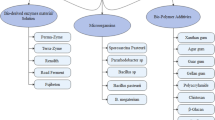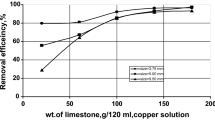Abstract
The formation features of nanoadsorption polyelectrolyte (PE) layers with the formation of a mineral-organic matrix on the surface of clay minerals and soils (kaolinite, montmorillonite, quartz sand, gray forest soil, and chernozemic soil) have been elucidated by direct adsorption measurements. It has been found that the experimental values for the limit adsorption of polyacrylamide (PAM) and polyacrylic acid (PAA) on all the minerals are significantly higher than the calculated values for the formation of a monolayer. This indicates adsorption on the surface of not only separate macromolecules but also secondary PE structures as packets or fibrils determining the cluster-matrix structure of the modified surface. The study of the electro-surface properties (electrophoretic mobility, electrokinetic potential, pH, and electroconductivity) of mineral and soil particles adsorption-modified with PEs has confirmed the differences in the adsorption mechanisms (from physical sorption to chemisorption) with the formation of surface compounds depending on the different polar groups of PEs and the mineral type.
Similar content being viewed by others
References
S. Brunauer, The Adsorption of Gases and Vapors. Vol. 1. Physical Adsorption (Princeton Univ. Press, 1943).
V. V. Dobrovol’skii, “The role of humic acids in the formation of migrational fluxes of heavy metals,” Eur. Soil Sci. 37(1), 24–30 (2004).
T. B. Ermakova and E. P. Sergeev, “Studying the structure and properties of adsorbed layers of polyelectrolytes on negatively charged surface,” in Structure and Dynamics of Molecular Systems (Yalchik, 2004), Vol. 2, pp. 181–185.
N. A. Gur’eva and A. I. Kurbatov, “Electrokinetic properties of solonetzes and solonetzic soils of northern Kazakhstan,” Izvest. TSKhA, No. 6, 119 (1971).
A. N. Zhukov, “Dependences of the point of zero charge and the isoelectric point of amphoteric solid surface on concentration and degree of binding of the ions of the background electrolyte. The case of 1: 1 electrolyte,” Colloid J. 58(2), 270–272 (1996).
A. I. Kurbatov, “Determination of the electrokinetic potential of soils,” Izvest. TSKhA, No. 5, 3–19 (1970).
G. N. Kurochkina and D. L. Pinskii, “Adsorption of polyelectrolytes on synthetic aluminosilicates of given composition,” Zh. Fiz. Khim. 76(6), 1113–1118 (2002).
G. N. Kurochkina and D. L. Pinskii, “The effect of pre-adsorption polyelectrolytes on hydrophilic-hydrophobic properties of synthetic aluminosilicates,” Zh. Fiz. Khim. 84(1), 81–89 (2010).
G. N. Kurochkina and D. L. Pinskii, “The formation of mineral-organic compounds and their effect on the surface properties of soil aluminosilicates,” Eur. Soil Sci. 37(4), 378–387 (2004).
G. N. Kurochkina and D. L. Pinskii, “Development of a mineralogical matrix at the adsorption of polyelectrolytes on soil minerals and soils,” Eur. Soil Sci. 45(11), 1057–1067 (2012).
G. N. Kurochkina, D. L. Pinskiy, G. N. Fedotov, M. Hajnos, Z. Sokolowska, and I. Ciesla, “Transformation of the structural organization of clay sediments and soils under the impact of polyelectrolytes,” Eur. Soil Sci. 46(8), 897–907 (2013).
G. N. Kurochkina, D. L. Pinskiy, M. Hajnos, Z. Sokolowska, I. Ciesla, and B. Gjegosh, “The impact of nanoadsorption layers of polyectrolytes on the stucture-sorptive properties of minerals and soils,” Agrokhimiya, No. 10, 58–66 (2013).
G. N. Kurochkina and O. A. Sokolov, “Kinetics of formation and properties of interphase hydrate films on the surface of anhydrous mineral constituents of soil,” Eur. Soil Sci. 32(7), 758–765 (1999).
Yu. S. Lipatov and L. M. Sergeeva, Polymer Adsorption (Naukova Dumka, Kiev, 1972 [in Russian].
D. L. Pinskii, Ion-Exchange Processes in Soils (ONTI PNTs RAN, Pushchino, 1997) [in Russian].
D. L. Pinskii, “Cluster-matric processes of soil formation and soil functioning,” in Biospheric Functions of the Soil Cover (Pushchino, 2010), pp. 240–242 [in Russian].
D. L. Pinskii and G. N. Kurochkina, “Specificity of the adsorption of polyacrylic acid by synthetic aluminosilicates,” Zh. Fiz. Khim. 79(10), 1853–1859 (2005).
D. L. Pinskii and G. N. Kurochkina, Soil Processes and the Spatial-Temporal Organization of Soils (Nauka, Moscow, 2006) [in Russian].
A. D. Pomogailo, “Metallopolymeric nanocomposite substances with controlled molecular arctitecture,” Zh. Ros. Khim. ob-va im. D.I. Mendeleeva 15(5) (2002).
P. A. Rebinder, Selected Works. Surface Phenomena in Disperse Systems. Colloidal Chemistry (Nauka, Moscow, 1979) [in Russian].
I. P. Sergeeva, T. B. Ermakova, V. D. Sobolev, and N. V. Churaev, “A study of the properities of hydrophobic surfaces by the capillary electrokinetic method,” in Structure and Dynamics of Molecular Systems, iss. 10, part 3, 49–52 (2003) [in Russian].
A. A. Slyusar’, O. A. Slyusar’, and N. M. Zdorenko, “Regulation of colloidal-chemical properties of kaolin clay suspensions by complex additives,” Nauchn. Vedom. Belgorod. Gos. Univ., Ser. Estestven. Nauki 15(9), 64–78 (2011).
A. V. Smagin and N. B. Sadovnikova, “The impact of strongly swelling polymeric hydrogels on the water retention capacity of coarse-textured soils,” Pochvovedenie, No. 11, 50–55 (1994).
O. A. Trubetskoi and O. E. Trubetskaya, “13C-NMR analysis of components of chernozem humic acids and their fractions with different molecular sizes and electrophoretic mobilities,” Eur. Soil Sci. 44(3), 281–285 (2011).
G. N. Fedotov, G. V. Dobrovol’skii, V. I. Putlyaev, A. V. Garshev, V. K. Ivanov, E. I. Pakhomov, “Gel structures in soils,” Eur. Soil Sci. 39(7), 738–747 (2006).
A. A. Shevchenko, Extended Abstract of Candidate’s Dissertation in Biology (Moscow, 2011).
T. V. Shnee, A. A. Shevchenko, and S. L. Belopukhov, “Solonetzic soils and changes in the electrokinetic potential,” Proc. Conf. Young Sci. of Peoples’ Friendship Univ. of Russia (Izd. RUDN, Moscow, 2009), pp. 212–214 [in Russian].
E. D. Shchukin, A. V. Pertsov, and E. A. Amelina, Colloidal Chemistry (Khimiya, Moscow, 1975) [in Russian].
A. Biegonowski, B. Witkowska-Walczak, J. Glinski, Z. Sokolowska, C. Slawinski, M. Brzezinska, T. Wlodarczyk, “Database of Polish arable mineral soils: a review,” Intern. Agrophys. 27, 335–350 (2013).
G. M. Day, B. T. Hart, I. D. McKelvie, and R. Beckett, “Adsorption of natural organic matter onto goethite,” Colloid. Surf., A: Physicochem. Engin. Aspects 89, 1–13 (1994).
D. Youjun, J. B. Dixon, and N. G. White, “Adsorption of polyacrylamide on smectite, illite, and kaolinite,” Soil Sci. Soc. Am. J. 70, 297–304 (2006).
T. B. Ermakova, I. P. Sergeeva, A. D. Anuchkina, V. D. Sobolev, N. V. Churaev, “Regularities of the two-layer adsorption of anionic surfactant and cationic polyelectrolyte on the fused quartz surface,” Colloid J. 67 (2005).
D. Pinskiy, “Clusters in Soils,” in Encyclopedia of Agrophysics (Springer Verlag, Hannover, 2011), pp. 385–387.
N. Senesi, F. R. Rizzi, P. Dellino, and P. Acquafredda, “Fractal dimension of humic acids in aqueous suspension as a function of pH and time,” Soil Sci. Soc. Am. J. 60(6), 1613–1678 (1996).
W. Nan, Zh. Lihua, Ts. Shiojenn, and H. Juh-Ping, “Influence of metal oxide nanoparticles concentration on their zeta potential,” J. Colloid. Interface Sci. 407, 22–28 (2013).
D. N. Hinckley, “Variability in “crystallinity” values among the kaolin deposits of the coastal plain of Georgia and South Carolina,” Clays Clay Miner. 11, 229–235 (1963).
Zetasizer Nano Series. User Manual Iss. 1.1 (Malvern Instr. Ltd, Worcestershire, U.K., 2004).
Author information
Authors and Affiliations
Corresponding author
Additional information
Original Russian Text © G.N. Kurochkina, D.L. Pinskii, M. Haynos, Z. Sokolowska, I. Tsesla, 2014, published in Pochvovedenie, 2014, No. 7, pp. 842–850.
Rights and permissions
About this article
Cite this article
Kurochkina, G.N., Pinskii, D.L., Haynos, M. et al. Electrokinetic properties of soil minerals and soils modified with polyelectrolytes. Eurasian Soil Sc. 47, 699–706 (2014). https://doi.org/10.1134/S1064229314070084
Received:
Published:
Issue Date:
DOI: https://doi.org/10.1134/S1064229314070084




